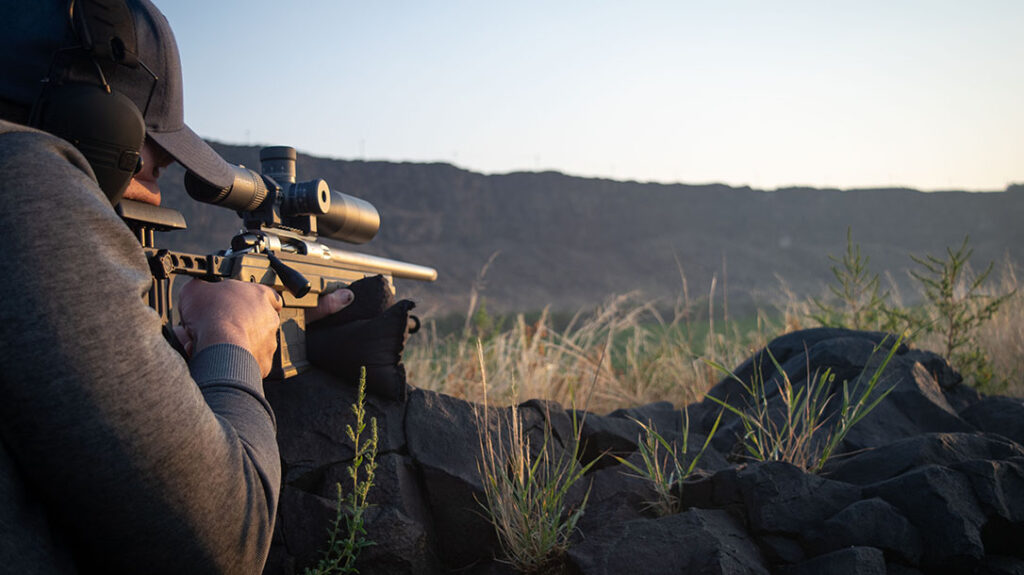Nothing is more disheartening and frustrating than a rifle out of zero. While being a little off is not a major issue, many times our brand-new rifle/scope combo isn’t even on paper. Fear not my fellow accuracy nerd, I have the magic formula to get you on paper and shooting groups in a hurry–a guide on how to sight in a riflescope.
How To Sight In a Riflescope
First, we need the correct setup to accomplish our task. To start, we need a shooting sled to stabilize the rifle. If you do not have one, you can use a sandbag or other similar item to rest the rifle on. You will need to stabilize the rifle both in the front of the gun as well as in the back. The more stable the rifle is, the greater the precision you can get in the sighting in process. While the opinions are many in this area, I suggest placing your target 25 to 50 yards downrange. This will allow us to more quickly get on paper and save ammunition.
Now that the gun is stable and pointed at our target, we now remove the bolt. Once it is out, move behind the gun and look down the barrel. Your goal is to get the barrel centered on your target downrange. Once you are happy, gently look up and check your scope to see where it is focused. With the gun bore sighted you should use your elevation and windage knobs to bring the crosshairs onto the target. Check your bore once again to confirm and then replace the bolt.
You are now bore sighted, which will at least have you on paper if you do it correctly. Prepare your rifle to fire now and load a round. Using the same stability assists we used previously, get the reticle directly on the center of the target. Slowly and precisely press the trigger and use good follow-through. Once the shot is complete, use your scope to check for bullet impact. If you had a good boresight, your round should have struck at least somewhere close to your aiming point.
Rounds on Target
If your round is now on target, you can move your target out to 100 yards, or the distance at which you want your official zero to be. If you have the calculations handy, you can adjust the elevation knob on your scope to your desired range. But if not, no worries. We can do it with another shot. Set yourself up once again in a stable fashion and fire another round. It is important that you take your time and make sure the shots are smooth with no trigger jerk or movement. Check through the scope for impact. Once you have it, you can now make the appropriate adjustments with your elevation and windage knobs.
It is important to know what your adjustments are. Scopes can vary in their adjustments as well as their design being MOA or MIL. As a general rule scopes in MOA adjust ¼ MOA with one click. That means at 100 yards, a click will move the reticle approximately ¼ inch. With MIL scopes, we see many with .10 MIL adjustments. At 100 yards, a 0.1-MIL click is 0.36 inches, and a full MIL is 3.6 inches. Practically speaking, 1/10-MIL equals 1 centimeter at 100 meters.
Group Therapy Time!
Once your adjustments are complete, fire a three-round group to confirm your zero. Depending on the rifle, these shots should be very close together. On a side note, there are two things to consider when sighting your rifle. You should use match-grade ammunition. This will give you consistency and a better chance of getting a good zero. Secondly, choose a day that is not super windy. As a rule, we do not dial our optics for wind. If your round is being pushed everywhere because of high winds, it can make getting a good zero very difficult.
Now that you are sighted in, I encourage you to use the zero stop on your riflescope if you have one. This will allow you to always dial back to zero if you change any settings. If you do not have a zero stop, record the position of your turrets so you can reference it and get the rifle back in zero. While it takes a few steps to accomplish, taking the time to correctly zero your rifle is worth it. You will enjoy better accuracy and have an overall better shooting experience.

Find a place to shoot at NSSF.org.


Didn’t find what you were looking for?
Read the full article here
